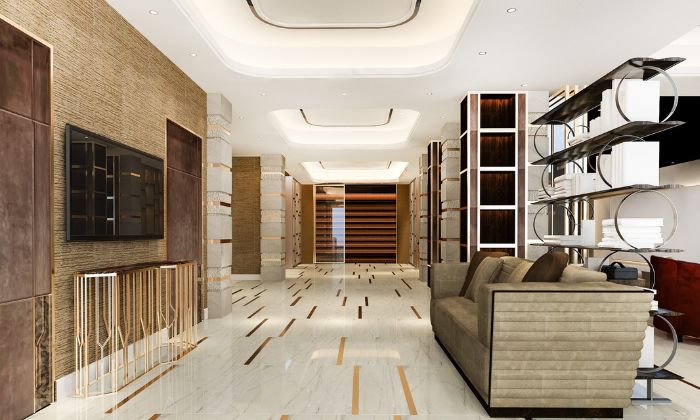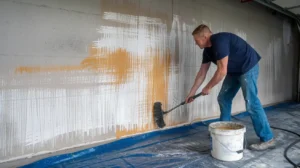Cultured marble is a popular choice for many home surfaces due to its attractive appearance and practical benefits. This material, a blend of natural marble dust and synthetic resins, offers a cost-effective alternative to natural stone.
In this guide, we’ll explore, what is calcutured marble? and everything you need to know about cultured marble, including its advantages, disadvantages, applications, and how it compares to other surfaces.

What is Cultured Marble?
Cultured marble is a man-made product composed of crushed marble mixed with synthetic resins. This blend creates a surface that mimics the look of natural marble but at a fraction of the cost. The resulting material is cast into molds to form various products like countertops, vanity tops, shower walls, and tubs.
Cultured marble vanity tops and cultured marble countertops are particularly popular due to their sleek, polished appearance and ease of maintenance. Unlike real marble, which can be quite porous and prone to staining. While on the other hand cultured marble is more stronger to protect the resin coating.
Advantages of Cultured Marble
Appearance
Cultured marble has a sleek, elegant appearance that mimics natural marble’s high-end look. It can be shaped into various forms, allowing for versatile design options. Available in numerous colors and patterns, it can provide different aesthetic preferences.
Whether opting for a traditional white or a unique custom design, cultured marble can be customized to match any style. Its polished finish adds a touch of luxury to any space, making it a popular choice for both modern and classic interiors.
Durability and Maintenance
Cultured marble is highly durable due to its synthetic resin composition, which enhances its resistance to stains and scratches. Unlike natural marble, it maintains its appearance over time with minimal wear. This durability makes it a practical choice for various surfaces.
Maintenance is straightforward; a simple wipe with mild detergent is usually enough to keep it clean. This ease of cleaning ensures that cultured marble retains its shine and attractiveness with minimal effort. Overall, its robustness and low-maintenance requirements make cultured marble a favorable option for both residential and commercial spaces.
Cost-effectiveness
Cultured marble is a cost-effective alternative to natural marble. It’s produced using a mix of crushed marble and resin, which is less expensive than mining and fabricating natural marble. The production process is simpler and less labor-intensive, reducing overall costs.
For homeowners seeking the elegance of marble without the high price, cultured marble offers a budget-friendly solution. Its affordability makes it an attractive option for those who want a marble-like look at a lower cost. Cultured marble’s price advantage comes from its easier manufacturing and material costs compared to natural stone.
Ease of Installation
Cultured marble is easier to install than natural stone due to its lightweight nature. It can be cut to precise dimensions with less effort, which simplifies the installation process. This ease of handling reduces the complexity of fitting it into various spaces.
Additionally, the straightforward installation can lead to lower labor costs. S0, installers can complete the job more quickly and efficiently. Overall, the user-friendly installation process makes cultured marble a cost-effective choice for many projects.
Variety of Styles and Colors
Cultured marble offers a vast array of styles and colors, making it highly versatile for various design needs. It can be customized to complement any interior decor, from traditional to modern. Whether you’re looking for cultured marble shower walls or elegant shower pans, the options are extensive.
This flexibility allows you to achieve the exact look as you want, enhancing the overall aesthetic of your space. Cultured marble can mimic natural stone or be tailored with unique patterns and hues. Its adaptability ensures it can fit seamlessly into any design vision.
Disadvantages of Cultured Marble
Potential for Scratches and Stains
Cultured marble is generally more resistant to stains and scratches compared to natural marble. However, it is not entirely scratch-proof or stain-resistant. Sharp objects can still scratch its surface, and abrasive cleaners may cause damage.
To maintain its appearance, use only non-abrasive cleaning products. Avoid placing hot items directly on the surface, as this can cause potential damage. Regular care and proper maintenance are essential to keep cultured marble looking its best.
Limitations Compared to Natural Marble
Cultured marble falls short compared to natural marble in several ways. Unlike natural marble, which boasts unique veining and color variations, cultured marble offers a more consistent and uniform appearance. This uniformity means it lacks the distinctive, individual characteristics found in each piece of natural marble.
For those seeking the authentic look and feel of real marble, cultured marble might not meet their expectations. Essentially, while cultured marble can mimic the appearance of natural marble, it does not replicate the unique, natural variations and beauty that come with genuine marble.
Environmental Considerations
Cultured marble is made from synthetic resins, which can have environmental impacts. The production of these resins involves chemicals that may not be eco-friendly. This process raises concerns about sustainability and the environmental footprint of cultured marble. If reducing your environmental impact is important, consider alternatives.
These alternatives might offer better eco-friendly credentials or use more sustainable materials. Evaluating the production practices and material sources of your choices can help you make a more informed decision. Look for options that prioritize eco-friendly processes and materials.
Applications of Cultured Marble
Bathroom Vanities and Countertops
Cultured marble is a popular choice for bathroom vanities and countertops because it combines style with functionality. It has a sophisticated look that mimics natural marble but is more affordable. Its non-porous surface resists moisture, making it perfect for humid bathroom conditions. This helps prevent the growth of mold and mildew.
Cultured marble is also easy to clean and maintain, which is ideal for busy bathrooms. Additionally, it is available in a range of colors and patterns, allowing for customization to match various bathroom designs. Overall, its durability and aesthetic appeal make it a practical and attractive option for bathroom surfaces.

Shower Walls and Tubs
Cultured marble shower walls and tubs are designed to provide a sleek, seamless appearance with minimal joints and grout lines. This design reduces the areas where dirt and grime can accumulate, making cleaning easier. The material is inherently water-resistant, which helps it withstand the constant exposure to moisture in bathrooms.
This resistance ensures durability and longevity in wet environments. Additionally, the smooth surface of cultured marble prevents the growth of mold and mildew, further simplifying maintenance. The aesthetic appeal of cultured marble can enhance the overall look of a bathroom, offering both functionality and style.

Flooring and Other Interior Uses
Cultured marble, though more frequently seen in countertops and vanities, can also be used for flooring and other interior applications. Its durability is a significant advantage, standing up well to foot traffic and daily wear. The ease of maintenance, with simple cleaning and resistance to stains, makes it practical for various surfaces.
Cultured marble’s smooth finish and aesthetic appeal add a touch of elegance to interiors. It can be customized in different colors and patterns, enhancing its versatility for different design styles. Additionally, its non-porous nature helps in maintaining hygiene. However, proper installation is crucial to ensure long-lasting performance. Overall, cultured marble offers a stylish and functional option for diverse interior uses.

Comparing Cultured Marble to Other Surfaces
Cultured Marble vs. Natural Marble
Cultured marble and natural marble are often compared due to their similar look. Natural marble is a genuine stone, characterized by its unique veining and texture, but it is more porous, requiring frequent sealing and maintenance. In contrast, cultured marble is a man-made material combining crushed marble with resin, offering a more consistent appearance and easier upkeep.
Cultured marble is less expensive and more durable, making it a practical choice for many applications. While natural marble boasts elegance and uniqueness, its higher cost and maintenance needs make cultured marble a popular alternative for budget-conscious and low-maintenance preferences.
Cultured Marble vs. Quartz
Cultured marble and quartz are both popular choices for countertops. Cultured marble is a blend of natural marble dust and resin, giving it a marble-like appearance but with added durability. It’s less expensive than quartz and can be molded into various shapes and sizes.
However, cultured marble is porous, which means it can stain and require more maintenance. Quartz countertops, on the other hand, are made from engineered stone that combines natural quartz crystals with resin. This makes them non-porous and highly resistant to staining, scratches, and impact.
Quartz offers a more consistent appearance and can be more expensive than cultured marble. While quartz requires less maintenance, both options provide durability and a stylish look for your kitchen or bathroom.
Cultured Marble vs. Granite
Cultured marble and granite are both popular choices for countertops but both have their own qualities. Granite is a natural stone renowned for its durability and unique patterns, making it highly resistant to heat and scratches. It requires periodic sealing to preserve its appearance but is generally more expensive.
Cultured marble, on the other hand, is an engineered product made from a blend of crushed marble and resin. While it offers a more uniform look and is less expensive than granite, it is less heat-resistant and can be more prone to scratches and staining. Granite’s natural beauty and strength make it a premium choice, whereas cultured marble offers a cost-effective and customizable alternative.
Conclusion
Cultured marble offers a versatile and cost-effective alternative to natural marble. Its range of styles, ease of maintenance, and affordability make it a popular choice for various applications in the home.
However, understanding its limitations and comparing it to other surfaces can help you make an informed decision for your next project. Transform your space with our expert services contact us if you have any query or want to take our services.
FAQs
How to clean cultured marble?
To clean cultured marble, use a mild, non-abrasive cleaner and a soft cloth. Avoid harsh chemicals or abrasive pads, which can damage the surface. For stubborn stains, a paste made from baking soda and water can be gently rubbed on the affected area.
How to cut cultured marble?
Cutting cultured marble requires a diamond-tipped saw blade. It’s best to have this done by a professional to ensure precise cuts and avoid damaging the material. If you are experienced with DIY projects, you can use a circular saw with the appropriate blade for cutting cultured marble.
What is white cultured marble?
White cultured marble is a variation of cultured marble that features a white base color. It is often chosen for its clean, classic look and is a popular choice for cultured marble vanity tops and countertops.
Can cultured marble be used outdoors?
While cultured marble is designed primarily for indoor use, some varieties can be used outdoors. However, exposure to harsh weather conditions can affect its appearance and durability. Always check with the manufacturer to ensure it is suitable for outdoor applications.
How do you repair a chip in cultured marble?
To repair a chip in cultured marble, clean the area thoroughly and apply a marble repair kit. These kits typically include resin that matches the color of the cultured marble. Follow the manufacturer’s instructions for mixing and applying the repair material, and allow it to cure fully before use.





